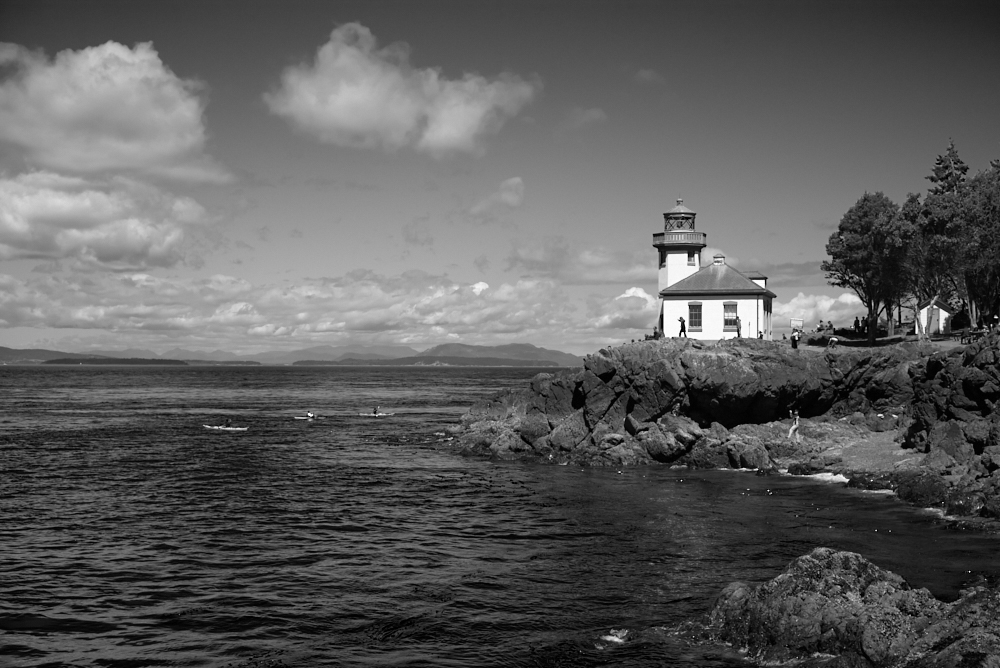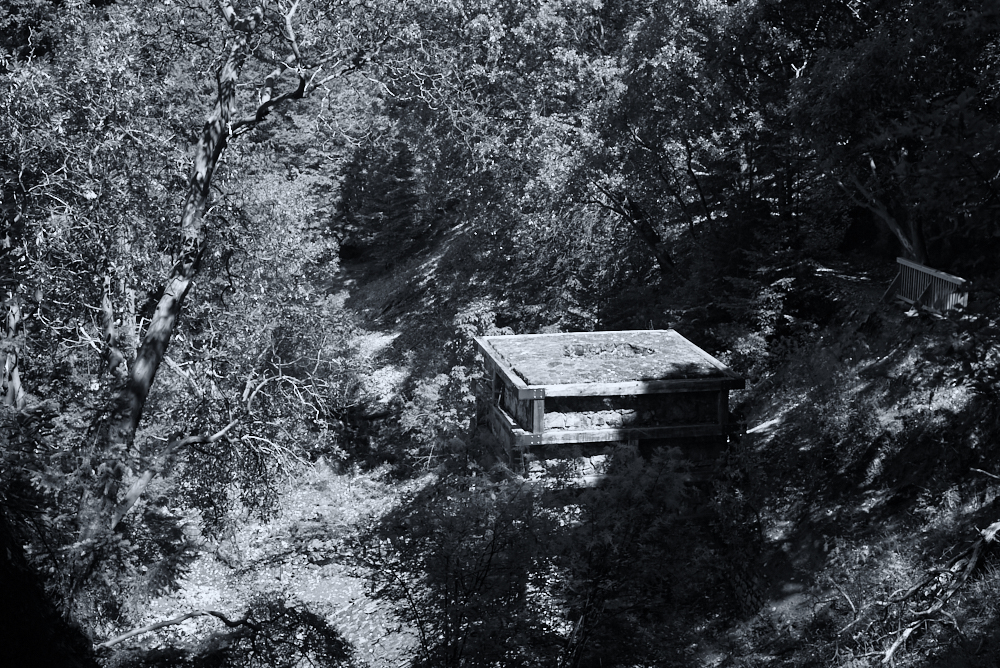The Salish Sojourn I
Lime Kiln Point, San Juan Island, Washington

Lime Kiln Park, San Juan Island
A sunny, Fourth of July weekend finds us at Lime Kiln Point State Park, which is on the western side of San Juan Island. The park, fronting Haro Strait, offers a number of attractions, including a lighthouse, an abandoned lime kiln from which it takes its name, and, supposedly, one of the best, land-based, Orca viewing sites in the world.
I am amazed, when we reach the parking lot, to find it virtually empty. A couple of cars, but no trouble parking. Two months earlier, out on the remote Washington coast, the parking lots were stuffed with cars, and natives were selling spots within walking distance of the beach. Where are all of the people? We walk through a grove of Madrone trees, twisted into surrealistic shapes by the pressure of the relentless wind, and reach a bluff overlooking the water. Placards describe the habits of the Orca, but, sadly, there are no whales cavorting among the waves. The only obvious critters are a flotilla of sea kayakers oaring past.

No Orcas, but plenty of sea-kayakers
A signpost suggests the existence of a cove, 0.3 miles to the south, and so we take a short walk along the sea-worn stone cliffs to Deadman's Bay. It is 10:30 in the morning, on the Fourth of July weekend, but, again, the beach is empty. I am amazed. I expected the island to be swarming with crowds today; this little gem of a beach should be packed. Nevertheless, we are alone. Where are all the people? Is there something we should know about Deadman's Bay, a reason that deters crowds?
If so, it's not the attractions. The tide pools at Deadman's Bay are amazing, offering an incredible range of red sea urchins, green and yellow sea anemones, and pink corals. There are also examples of chitons, grey, armor-plated molluscs which are essentially the armadillos of the sea: they cling tightly to the rocks at low tide, and if pried off, can roll into a bony ball to protect their soft undersides.
We are amused by a pool in a valley between two rocks in which hermit crabs are dueling over empty snail shells. The basic gambit is to lock one claw onto a shell just slightly larger than the one you currently own, and drag it away from competitors. This does not always go smoothly, and when another buyer fancies your prospective home, a drawn out tug-of-war can ensue. We watch as, in the claw-pinch-claw world of the hermit crab, two antagonists battle it out for the privilege of owning a shell of dubious quality.
The entertainments are varied. This underexploited strip of drift logs, pebble beach, and tide pools is vastly superior to any place I've seen on the Oregon coast over the past decade. We spend an hour examining the rich marine life, before returning to our exploration of the park.

Lime Kiln Point Lighthouse
Back at the Orca viewing station, and there are still no whales. More people, however, have arrived. We hike north to the small lighthouse, which now serves as both navigational aid and Orca resource center. Built in 1919, the Lime Kiln Lighthouse is the youngest of all the lighthouses in Washington. It is also one of the smaller houses. It is built on stone, twenty feet above the high tide mark. A thirty-eight foot tower, rising from the building that once housed the foghorn, contains a small light that flashes every ten seconds. In 1985, the lower half of the lighthouse was turned over to the scientists, and today it houses information about Orcas, as well as hydrophones to monitor their progress as they move across Haro Strait.
The trail continues north to the site of the old lime kiln. In the early days of European settlement, San Juan Island was a major source of quicklime. Quicklime is made by heating limestone to a temperature of 1,600 degrees. Carbon dioxide is released from the stone, and it breaks down into a fine powder — quicklime — which is used in cement, mortar, steel, and paper.
The kiln on San Juan was established in 1860, and for nearly eighty years, limestone was mined, burned, and shipped from this site. The nearby hills were stripped of trees to feed the ravenous kiln — three cords of firewood were required for every day's operation. Workmen loaded the kiln with broken limestone from the top, while firemen fed the flames below, maintaining the heat required to reduce the stone to quicklime. The product, a fine powder, was sealed into barrels that were shipped to west coast ports to supply the industrial needs of a growing country. At one time there was a wharf that extended into the water near Lime Kiln Point, but the currents are strong and treacherous here and more than one ship foundered with its load. Quicklime has another dangerous property: if it gets wet, it burns. Life as a sailor on an old wooden quicklime freighter would have been an interesting experience.
Economics — the downturn of markets during the Great Depression — as well as a depletion of high quality limestone in the area, led to the closure of the kiln. I'm certain Donald Trump has a plan to get these jobs back for the disenfranchised kiln operators, but until that happens, we can simply admire the foundations of this earliest remnant of San Juan industry, standing alone in a small clearing at the northern edge of the park.

Remains of the old lime kiln
There can be little doubt that Lime Kiln Point State Park is well worth a visit. Although I am told that it gets busy when the Orcas are running, it was very quiet during our time there. A premier site, catering to a wide variety of interests. I would visit again.
If you are enjoying this series, why not subscribe to Richard's monthly newsletter, What's New in Old News? The Peripatetic Historian is on the road, roaming the world and compiling fresh adventures. Don't miss out. Click here to join the legions of above-average readers who have already subscribed.